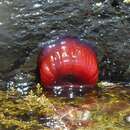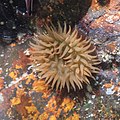en
names in breadcrumbs


Despite its stinging cells, the grey sea slug, Aeolidia papillosa preys on A. equina. The sea slug somehow does not digest the most toxic stinging cells.
Known Predators:
An anemone is a "solitary polyp." Actinia equina has a wide array of color variation, from green to red. The most common hue is rust-red. The beadlet anemone also varies greatly in body size, from 0.01 to 0.84 g dry weight. However, when anemones are in the water their body mass is primarily the amount of water absorbed in the tissue and in the gastrovascular cavity.
The anatomy is most easily divided into three parts: the tentacles, the body column (which houses the gastrovascular cavity, the pharynx, the gonads, and the retractor muscles), and the base (which includes the base foot that binds to a solid surface).
A classic characteristic of Actinia equina, and all anemones, is the beautiful tentacles with which the anemone traps and ingests its prey. Embedded at the end of the body column and in the tentacles are cnidoblasts, storage cells which house the nematocyst (stinging cell). In the beadlet anemone, the unbanded tentacles (up to 192) are arranged radially in six circles around the opening to the gastrovascular cavity. Bright blue spots, called acrorhagi, are below the tentacles on the outer margin of the column and look like warts. These distinguish A. equina and A. fragacea.
Range mass: 0.01 to .84 g.
Average mass: 0.42 g.
Other Physical Features: ectothermic ; heterothermic ; radial symmetry
Actinia equina is a considerably versatile intertidal sea anemone. Attaching to rocks, stones or other hard substrates, it is usally found near shore but can live in subtidal areas up to 20 m. The beadlet anemone can survive completely submerged in water or completely out of the water, high up on shores. Sometimes it even has to survive covered in sand, due to wind. However, it is always retracted when it is out of the water, looking like a little red blob.
Since Actinia equina is an intertidal specimen, it is exposed to a wide range of temperatures, but its optimum temperature for growth is 18.7 -19.9 degrees Celsius. The beadlet anemone slso tolerates waters with variable salinity, such as estuaries.
Range depth: 20 (high) m.
Habitat Regions: temperate ; saltwater or marine
Aquatic Biomes: coastal
Other Habitat Features: estuarine ; intertidal or littoral
Actinia equina is found primarily in the North Atlantic Ocean and the Mediterannean Sea. One of the most abundant concentrations of the species can be found around the British Isles. Populations also exist stretching down along Africa's Atlantic coast.
Biogeographic Regions: atlantic ocean (Native )
Actinia equina is a member of the Actinarian order, wich has a total of 13 known species. Actinia equina is sometimes divided into subspecies based on morphology. Recent genetic studies suggest the different colored Actinia equina may actually be distinct species.
In Anthozoans, specialized sensory organs are absent and nerves are arranged in nerve nets. Most nerve cells allow impulses to travel in either direction. Hairlike projections on individual cells are mechanoreceptors and possible chemoreceptors. Some Anthozoans show a sensitivity to light.
Communication Channels: tactile ; chemical
Perception Channels: tactile ; chemical
US Federal List: no special status
CITES: no special status
Actinia equina are the only species of anemone to brood their young (viviparous reproduction). The anemone begins as a planktonic larval stage where it crawls out of its parent and is free in the ocean for a short period of time. After that, it enters the cavity of another sea anemone, male or female, and further develops. Once the juvenile anemone is ready to be "born", the "parent" anemone catapults the new individual through the water where it lands and subsequentially secures itself on solid, solitary substrate.
Actinia equina is one of the more aggressive sea anemones. It has powerful toxins (e.g. equistatin and equinatoxin) in its nematocysts that it uses for feeding and defense. If a human comes in contact with it, it can cause great discomfort and pain.
Negative Impacts: injures humans (bites or stings)
A study conducted by Hutton and Smith (1996) found that amoebocytes contain antibacterial properties which seem to function differently than other antibiotic properties found in animals. They seem to be able to fight bacterial infections without the use of an enzyme called lysozyme. Lysozymes are found across a wide number of phyla and are what organisms commonly use to fight bacteria. The chemicals produced by the beadlet anemone could possibly be harnessed for use in medicine or conservation (protecting plants against foreign bacteria).
Positive Impacts: source of medicine or drug
Anthozoans often provide fish and crustaceans with habitat and food scraps. The fish and crustaceans provide protection from some predators and sediment fouling.
Actinia equina is known for eating almost anything it can catch. The most abundant food sources for this anemone are: bivalve mollusks, insects, and isopods. However larger organisms such as gastropods (snails and slugs), bryozoans, and chitons are what provide the largest food mass. When the anemone "senses" the presence of potential prey, it attacks the organism using its nematocysts. The stinging cell is uncoiled and can release toxins into prey. These toxins paralyze the organism, inhibiting its ability to escape. Actinia equina was shown to have the fastest digestion rate of all the species in the Actinia genus.
Animal Foods: mollusks; other marine invertebrates
Primary Diet: carnivore (Insectivore , Eats non-insect arthropods, Molluscivore , Eats other marine invertebrates)
The sperm from males goes into the gastrovascular cavity, where the egg is fertilized and then develops. Actinia equina are the only species of anemone to brood their young (viviparous reproduction). Although Actinia equina can reproduce sexually, they can also reproduce asexually through parthenogenesis of vegetative growth (e.g. regeneration or basal laceration).
Key Reproductive Features: simultaneous hermaphrodite; sexual ; asexual ; fertilization (External ); viviparous
The anemone begins as a planktonic larval stage where it crawls out of its parent and is free in the ocean for a short period of time. After that, it enters the cavity of another sea anemone, male or female, and further develops. Once the juvenile anemone is ready to be "born", the "parent" anemone catapults the new individual through the water where it lands and subsequentially secures itself on solid, solitary substrate.
Parental Investment: no parental involvement; pre-fertilization (Provisioning); pre-hatching/birth (Protecting: Female); pre-independence (Protecting)
The beadlet anemone (Actinia equina) is a common sea anemone found on rocky shores around all coasts of the British Isles. Its range extends to the rest of Western Europe and the Mediterranean Sea, and along the Atlantic coast of Africa as far south as South Africa.
Actinia equina can be found both in exposed and sheltered situations. It is highly adapted to the intertidal zone as it can tolerate both high temperatures and desiccation. The anemone may also be found in regions of variable salinity such as estuaries.
Beadlet anemones can live in solitary or in aggregations. Solitary beadlet anemones are found to be larger-sized than those that form clustered aggregation. Furthermore, larger sea anemones were found submerged in low tide, where they have greater access to food resources and are less subjected to harsh environmental exposures. The size of beadlet anemones may be connected to their physiological adaptation in regards to limited food resources and withstanding environmental conditions.[1]
Underwater, it displays up to 192 tentacles, arranged in six circles. Out of water, the tentacles retract and the anemone resembles a blob of red, brown, green or orange jelly, up to about 5 centimetres (2.0 in) across. It has bright blue beads (known as acrorhagi) located just beneath the tentacles, organised as an external ring containing stinging cells located at the top of the column that it uses to fight over territory. The acrorhagi contains the cnidocysts which themselves contain the nematocysts. There is some evidence that the various colour forms may in fact be different species.
Actinia equina is similar in form to the Waratah anemone (Actinia tenebrosa) of Australia and New Zealand. It is also similar in form to the strawberry anemone (Actinia fragacea) but is a uniform colour and is typically rather smaller.
Actinia equina is viviparous, with up to one hundred embryos developing inside the body cavity before being ejected into the open water as juveniles.[2] A particularly famous example was that of "Granny" which was found on Scotland's east coast by John Dalyell in 1828 and produced several hundred offspring until it died in 1887.[3]
The beadlet anemone (Actinia equina) is a common sea anemone found on rocky shores around all coasts of the British Isles. Its range extends to the rest of Western Europe and the Mediterranean Sea, and along the Atlantic coast of Africa as far south as South Africa.
Actinia equina can be found both in exposed and sheltered situations. It is highly adapted to the intertidal zone as it can tolerate both high temperatures and desiccation. The anemone may also be found in regions of variable salinity such as estuaries.
Beadlet anemones can live in solitary or in aggregations. Solitary beadlet anemones are found to be larger-sized than those that form clustered aggregation. Furthermore, larger sea anemones were found submerged in low tide, where they have greater access to food resources and are less subjected to harsh environmental exposures. The size of beadlet anemones may be connected to their physiological adaptation in regards to limited food resources and withstanding environmental conditions.
Underwater, it displays up to 192 tentacles, arranged in six circles. Out of water, the tentacles retract and the anemone resembles a blob of red, brown, green or orange jelly, up to about 5 centimetres (2.0 in) across. It has bright blue beads (known as acrorhagi) located just beneath the tentacles, organised as an external ring containing stinging cells located at the top of the column that it uses to fight over territory. The acrorhagi contains the cnidocysts which themselves contain the nematocysts. There is some evidence that the various colour forms may in fact be different species.
Actinia equina is similar in form to the Waratah anemone (Actinia tenebrosa) of Australia and New Zealand. It is also similar in form to the strawberry anemone (Actinia fragacea) but is a uniform colour and is typically rather smaller.
Actinia equina is viviparous, with up to one hundred embryos developing inside the body cavity before being ejected into the open water as juveniles. A particularly famous example was that of "Granny" which was found on Scotland's east coast by John Dalyell in 1828 and produced several hundred offspring until it died in 1887.



